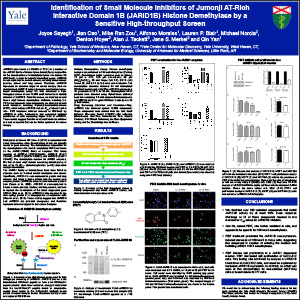Identification of Small Molecule Inhibitors of Jumonji AT-Rich Interactive Domain 1B (JARID1B) Histone Demethylase by a Sensitive High-throughput Screen
Joyce Sayegh1, Jian Cao1, Mike Ran Zou1, Alfonso Morales1, Lauren P. Blair1, Michael Norcia2, Denton Hoyer2, Alan J. Tackett3, Jane S. Merkel2 and Qin Yan1
1Department of Pathology, Yale School of Medicine, New Haven, CT; 2Yale Center for Molecular Discovery, Yale University, West Haven, CT; 3Department of Biochemistry and Molecular Biology, University of Arkansas for Medical Sciences, Little Rock, AR
ABSTRACT
JARID1B (also known as KDM5B or PLU1) is a member of the JARID1 family of histone lysine demethylases responsible for the demethylation of trimethylated lysine 4 in histone H3 (H3K4me3), a mark for actively transcribed genes. JARID1B is over-expressed in several cancers, including breast cancer, prostate cancer and lung cancer. Therefore, JARID1B represents an attractive target for cancer therapy. Here we characterized JARID1B using a homogeneous luminescence-based demethylase assay. We then conducted a high-throughput screen of over 15,000 small molecules to identify inhibitors of JARID1B. From this screen, we identified several known JmjC histone demethylase inhibitors, including 2,4-PDCA and catechols. More importantly, we identified several novel inhibitors, including N-phenyl-benzisothiazolinone (PBIT), which inhibits JARID1B with an IC50 of about 3 µM in vitro. PBIT treatment inhibited removal of H3K4me3 by JARID1B in cells. Furthermore, this compound inhibited proliferation of cells expressing higher level of JARID1B. These results suggest that this novel small molecule inhibitor is a lead compound that can be further optimized for cancer therapy.
©2013 Yale Department of Pathology. All rights reserved.
Any redistribution or reproduction of part or all of the contents in any form is prohibited. You may not, except with express written permission of the author or the Department of Pathology, distribute or commercially exploit the content, nor may you transmit it or store it in any other website or other form of electronic retrieval system, including use for educational purposes.
